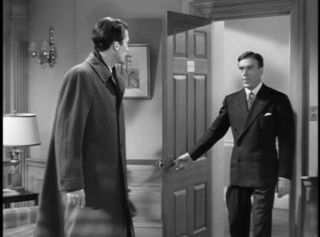The MacGuffin: News and Comment (11/Jul/2009)
(c) Ken Mogg (2004)
July 11
Prompted by a magnificent exhibit running at the National Gallery of Victoria on the work of Salvador Dali (the exhibit draws on major Dali collections in Spain and Florida), I'm turning this week to Hitchcock's film Spellbound (1945) with its dream sequence based on Dali designs. I'll come to the dream sequence later. But first, note the frame-capture below in which new arrival 'Dr Edwardes' (Gregory Peck) turns to see the retiring head of 'Green Manors', Dr Murchison (Leo G. Carroll), enter the staff common room to welcome him. What follows is what I once called 'one of the great "bluffing" scenes in movies'. Dr Murchison professes not to have previously met the man who has come to replace him, commenting, 'You're younger than I thought you would be.' What is actually going through his head at this moment must be total consternation. For one thing, he knows that the person he is addressing is an impostor and that the real Dr Edwardes is dead - Murchison himself had killed him! (The dream sequence will reveal what had happened: that Murchison, who is insane, had followed the real Edwardes and a companion, the man who now stands before him, John Ballyntine, to a remote ski resort called Gabriel Valley where he had shot Edwardes. Immediately afterwards, Ballyntine had suffered amnesia and taken Edwardes's place. The whole thing is improbable in the extreme - like a dream. In these respects, it closely anticipates the murder scheme in Vertigo, and Dr Murchison is the predecessor of that film's villain, Gavin Elster.) For another thing, Murchison, knowing that the real Edwardes is dead, must have wondered who he was going to see when he met the new arrival. He may have guessed that it would be Ballyntine, and that the latter must have suffered amnesia or some such condition, but how could he be sure? (For that matter, why hadn't he shot Ballyntine straight after Edwardes? He could hardly have known that the only witness to Edwardes's murder would conveniently lose his memory! Read on.) There's a related matter. Prior to the murder, all three men - Edwardes, Ballyntine, and Murchison - had met in the Twenty-One Club in New York, where a dangerously jealous Murchison had quarreled with Edwardes, knowing that the latter was due to replace him as head of Green Manors. Obviously Ballyntine had witnessed this quarrel (the dream sequence confirms this), and presumably Murchison knew who he was, for hadn't he then followed Edwardes and Ballyntine to Gabriel Valley? In other words, Murchison has seen Ballyntine on two occasions prior to the latter's turning up at Green Manors. Yet here we watch him entering the staff room, his mind, although unhinged, presumably in turmoil, yet not batting an eyelid! As I say, it's one of the great 'bluffing' scenes in movies - by which I mean both that Murchison is feigning being amiable and not having seen Ballyntine before, and that the filmmakers themselves - director Hitchcock and his writers - are bluffing that this scene is even remotely plausible! Of course, that's hardly the issue. As I've noted, the whole conception of the film is to give it the verisimilitude of a dream but also something of a dream's crazy logic. In this, I think the filmmakers succeed admirably. And another thing now. The shot of Murchison entering the room contributes to at least two of the film's visual motifs. Doors and doorways are continually emphasised in Spellbound, beginning with an introductory text which refers to 'the locked doors of [the] mind'. (In the same vein, the film is like a labyrinth, and we learn that Dr Edwardes had written a book called 'The Labyrinths of the Guilt Complex'.) When Dr Constance Petersen (Ingrid Bergman) falls in love with the newcomer, it is symbolised by a shot of successive doors opening, with a white radiance beyond. Both the doors and the white radiance are integral to Spellbound's design. Murchison, though, is specifically associated with entering rooms unannounced. On the first occasion, he excuses himself, when he appears at the doorway of Constance's office, by saying, 'Pardon me for marching in.' But arguably the subliminal effect on the viewer is that there is something not quite right, that the character hasn't been vouched for. An identical effect is used to introduce the villain of Kenneth Branagh's Spellbound spin-off, Dead Again (1991). More next time.
This material is copyright of Ken Mogg and the Hitchcock Scholars/'MacGuffin' website (home page) and is archived with the permission of the copyright holder. |

